Influence of Crops and Different Production Systems on Soil Carbon Fractions and Carbon Sequestration in Rainfed Areas of Semiarid Tropics in India
Abstract
:1. Introduction
2. Materials and Methods
2.1. Study Area
2.2. Experimental Design
2.3. Soil Sampling and Analysis
2.3.1. Soil Carbon Stock
2.3.2. Water Holding Capacity and Total Porosity
2.3.3. Soil Carbon Fractions
2.3.4. Soil Bulk Density
2.4. Statistical Analysis
3. Results
3.1. Soil Bulk Density, Porosity and Water Holding Capacity
3.2. Total Carbon (TC), total Inorganic Carbon (TIC) and Total Organic Carbon (TOC)
3.3. Soil Organic C Pools
3.4. Carbon Sequestration
3.5. Crops Yield
4. Discussion
5. Conclusions
Author Contributions
Funding
Institutional Review Board Statement
Informed Consent Statement
Data Availability Statement
Acknowledgments
Conflicts of Interest
References
- Lal, R.; Follett, R.F.; Kimble, J.; Cole, C.V. Managing, U.S. cropland to sequester carbon in soil. J. Soil Water Conserv. 1999, 54, 374–381. [Google Scholar]
- Carter, M.R. Soil quality for sustainable land management: Organic matter and aggregation interactions that maintain soil functions. Agron. J. 2002, 94, 38–47. [Google Scholar] [CrossRef]
- Hancock, G.R.; Wells, T. Predicting soil organic carbon movement and concentration using a soil erosion and Landscape Evolution Model. Geoderma 2021, 382, 114759. [Google Scholar] [CrossRef]
- Paustian, K.; Six, J.; Elliott, E.T.; Hunt, H.W. Management options for reducing CO2 emissions from agricultural soils. Biogeochemistry 2000, 48, 147–163. [Google Scholar] [CrossRef]
- Six, J.; Jastrow, J.D. Organic matter turnover. In Encyclopedia of Soil Science; Lal, R., Ed.; Marcel Dekker: New York, NY, USA, 2002; pp. 936–942. [Google Scholar]
- Sharma, P.K.; Bhushan, L. Physical characterization of a soil amended with organic residues in a rice-wheat cropping system using a single value soil physical index. Soil Tillage Res. 2001, 60, 143–152. [Google Scholar] [CrossRef]
- Gong, W.; Yan, X.Y.; Wang, J.Y.; Hu, T.X.; Gong, Y.B. Long-term manuring and fertilization effects on soil organic carbon pools under a wheat-maize cropping system in North China Plain. Plant Soil 2009, 314, 67–76. [Google Scholar] [CrossRef]
- Lal, R. Carbon sequestration potential of rainfed agriculture. Indian J. Dryland Agric. Res. Dev. 2010, 25, 1–16. [Google Scholar]
- Ciampitti, I.A.; Garcia, F.O.; Picone, L.I.; Rubio, G. Soil carbon and phosphorus pools in field crop rotations in Pampean soils of Argentina. Soil Sci. Soc. Am. J. 2011, 75, 616–625. [Google Scholar] [CrossRef]
- Schuman, G.E.; Janzen, H.H.; Herrick, J.E. Soil carbon dynamics and potential carbon sequestration by rangelands. Environ. Pollut. 2002, 116, 391–396. [Google Scholar] [CrossRef]
- Mandal, B.; Majumder, B.; Bandyopadhyay, P.K.; Hazra, G.C.; Gangopadhyay, A.; Samantaray, R.N. The potential of cropping systems and soil amendments for carbon sequestration in soils under long-term experiments in subtropical India. Global Chang. Biol. 2007, 13, 357–369. [Google Scholar] [CrossRef]
- Majumder, B.; Mandal, B.; Bandyopadhyay, P.K.; Gangopadhyay, A.; Mani, P.K.; Kundu, A.L. Organic amendments influence soil organic carbon pools and crop productivity in a 19 years old rice–wheat agroecosystems. Soil Sci. Soc. Am. J. 2008, 72, 775–785. [Google Scholar] [CrossRef]
- Lal, R. Soil carbon sequestration for climate change mitigation and food security. In Souvenir, Platinum Jubilee Symposium on Soil Science in Meeting the Challenges to Food Security and Environmental Quality; Indian Society of Soil Science: New Delhi, India, 2009; pp. 39–46. [Google Scholar]
- Manns, H.R.; Parkin, G.W.; Martin, R.C. Evidence of a union between organic carbon and water content in soil. Can. J. Soil Sci. 2016, 96, 305–316. [Google Scholar] [CrossRef] [Green Version]
- Srivastava, A.; Saco, P.M.; Rodriguez, J.F.; Kumari, N.; Chun, K.P.; Yetemen, O. The role of landscape morphology on soil moisture variability in semi-arid ecosystems. Hydrol. Process. 2021, 35, e13990. [Google Scholar] [CrossRef]
- Paustian, K.; Parton, W.J.; Persson, J. Modeling soil organic matter in organic amended and nitrogen-fertilized long-term plots. Soil Sci. Soc. Am. J. 1992, 56, 476–488. [Google Scholar] [CrossRef]
- Salinas-Garcia, J.R.; Hons, F.M.; Matocha, J.E. Long-term effects of tillage and fertilization on soil organic matter dynamics. Soil Sci. Soc. Am. J. 1997, 61, 152–159. [Google Scholar] [CrossRef]
- Silveira, M.L.; Comerford, N.B.; Reddy, K.R.; Cooper, W.T.; El-Rifai, H. Characterization of soil organic carbon pools by acid hydrolysis. Geoderma 2008, 144, 405–414. [Google Scholar] [CrossRef]
- Lal, R. Enhancing crop yield in the developing countries through restoration of soil organic carbon pool in agricultural lands. Land Degrad. Dev. 2006, 17, 197–209. [Google Scholar] [CrossRef]
- Lal, R. Enhancing eco-efficiency in agroecosystems through soil carbon sequestration. Crop Sci. 2010, 50, S120–S131. [Google Scholar] [CrossRef] [Green Version]
- Lal, R. Beyond Copenhagen: Mitigating climate change and achieving food security through soil carbon sequestration. Food Sec. 2010, 2, 169–177. [Google Scholar] [CrossRef]
- Kauppi, P.; Sedjo, R.; Apps, M.; Cerri, C.; Fujimoro, T.; Janzen, H. Technological and economic potential of options to enhance, maintain and manage biological carbon reservoirs and geo-engineering. In Climate Change 2001—Mitigation; Metz, B., Davidson, O., Swart, R., Pan, J., Eds.; Cambridge Univ. Press: Cambridge, UK, 2001; p. 343. [Google Scholar]
- Graham, M.H.; Haynes, R.F.; Meyer, J.H. Soil organic matter content quality: Effects of fertilizer applications, burning and trash retention on a long-term sugarcane experiment in South Africa. Soil Biol. Biochem. 2002, 34, 93–102. [Google Scholar] [CrossRef]
- Russell, A.E.; Larid, D.A.; Parkin, T.B.; Mallarino, A.P. Impact of nitrogen fertilization and cropping system on carbon sequestration in Midwestern Mollisols. Soil Sci. Soc. Am. J. 2005, 69, 413–422. [Google Scholar] [CrossRef] [Green Version]
- Moraif, F.; Lugato, E.; Berti, A.; Giardini, L. Long-term effects of recommended management practices on soil carbon changes and sequestration in north-eastern Italy. Soil Use Manag. 2006, 22, 71–81. [Google Scholar]
- Paul, E.A.; Paustian, K.; Elliott, E.T.; Cole, C.V. Soil Organic Matter in Temperate Agroecosystems: Long-term Experiment in North America; CRC Press: Boca Raton, FL, USA, 1997; p. 414. [Google Scholar]
- Böhme, L.; Langer, U.; Böhme, F. Microbial biomass enzyme activities and microbial community structure in two European long-term field experiments. Agric. Ecosyst. Environ. 2005, 109, 141–152. [Google Scholar] [CrossRef]
- Rudrappa, L.; Purakayastha, T.J.; Singh, D.; Bhadraray, S. Long-term manuring and fertilization effects on soil organic carbon pools in a Typic Haplustept of semi-arid sub-tropical India. Soil Tillage Res. 2006, 88, 180–192. [Google Scholar] [CrossRef]
- Li, Z.P.; Liu, M.; Wu, X.C.; Han, F.X.; Zhang, T.L. Effects of long-term chemical fertilization and organic amendments on dynamics of soil organic C and total N in paddy soil derived from barren land in subtropical China. Soil Tillage Res. 2010, 106, 268–274. [Google Scholar] [CrossRef]
- Rahman, M.M. Potential supplies and use efficiencies of nutrients from different organic wastes under tomato cultivation. Ann. Bangladesh Agric. 2012, 16, 25–39. [Google Scholar]
- Rahman, M.M. Nutrient-use and carbon sequestration efficiencies in soils from different organic wastes in rice and tomato cultivation. Commun. Soil Sci. Plant Anal. 2013, 4, 1457–1471. [Google Scholar] [CrossRef]
- Verma, S.; Sharma, P.K. Effect of long-term manuring and fertilizers on carbon pools, soil structure, and sustainability under different cropping systems in wet-temperate zone of northwest Himalayas. Biol. Fertil. Soils 2007, 44, 235–240. [Google Scholar] [CrossRef]
- Ding, X.; Han, X.; Liang, Y.; Qiao, Y.; Li, L.; Li, N. Changes in soil organic carbon pools after 10 years of continuous manuring combined with chemical fertilizer in a Mollisol in China. Soil Tillage Res. 2012, 122, 36–41. [Google Scholar] [CrossRef]
- Lal, R. Soil carbon sequestration to mitigate carbon sequestration. Geoderma 2004, 123, 1–22. [Google Scholar] [CrossRef]
- Srinivasarao, C.; Venkateswarlu, B.; Lal, R.; Singh, A.K.; Kundu, S.; Vittal, K.P.R.; Patel, J.J.; Patel, M.M. Long-term manuring and fertilizer effects on depletion of soil organic carbon stocks under pearl millet-cluster bean-castor rotation in western India. Land Degrad. Dev. 2011, 25, 173–183. [Google Scholar] [CrossRef]
- Srinivasarao, C.; Deshpande, A.N.; Venkateswarlu, B.; Lal, R.; Singh, A.K.; Kundu, S. Grain yield and carbon sequestration potential of post monsoon sorghum cultivation in Vertisols in the semi-arid tropics of central India. Geoderma 2012, 176, 90–97. [Google Scholar] [CrossRef]
- Srinivasarao, C.; Venkateswarlu, B.; Lal, R.; Singh, A.K.; Kundu, S.; Jakkula, V.S. Carbon sink capacity and agronomic productivity of soils of semiarid regions of India. In Principles of Sustainable Soil Management in Agroecosystems; Lal, R., Stewart, B.A., Eds.; CRC Press: Boca Raton, FL, USA, 2013; p. 568. [Google Scholar]
- Srinivasarao, C.; Venkateswarlu, B.; Lal, R.; Singh, A.K.; Kundu, S. Sustainable management of soils of dryland ecosystems of India for enhancing agronomic productivity and sequestering carbon. Adv. Agron. 2013, 2013, 253–329. [Google Scholar]
- Gopinath, K.A.; Saha, S.; Mina, B.L.; Pande, H.; Srivastva, A.K.; Gupta, H.S. Bell pepper yield and soil properties during conversion from conventional to organic production in Indian Himalayas. Sci. Hortic. 2009, 122, 339–345. [Google Scholar] [CrossRef]
- Walkley, A.; Black, C.A. Estimation of organic carbon by chromic acid titration method. Soil Sci. 1934, 37, 29–38. [Google Scholar] [CrossRef]
- Nelson, D.W.; Somners, L.E. Total carbon, organic carbon, and organic matter, In Methods of Soil Analysis, Part 3, 2nd ed.; Page, A.L., Ed.; American Society of Agronomy: Madison, WI, USA, 1996; pp. 961–1010. [Google Scholar]
- Batjes, N.H. Total carbon and nitrogen in the soils of the world. Eur. J. Soil Sci. 1996, 47, 151–163. [Google Scholar] [CrossRef]
- Baruah, T.C.; Barthakur, H.P. A Text Book of Soil Analysis; Vikas Publishing House Pvt. Ltd.: New Delhi, India, 1997; p. 234. [Google Scholar]
- Chan, K.Y.; Bowman, A.; Oates, A. Oxidizable organic carbon fractions and soil quality changes in an oxic paleustaff under different pastures leys. Soil Sci. 2001, 166, 61–67. [Google Scholar] [CrossRef]
- Blake, G.R.; Hartge, K.H. Bulk density. In Methods of Soil Analysis. Part I: Physical and Mineralogical Methods, Agronomy Monograph No. 9; Klute, A., Ed.; ASA-SSSA: Madison, WI, USA, 1986; pp. 363–375. [Google Scholar]
- Werner, M.R. Soil quality characteristics during conversion to organic orchard management. Appl. Soil Ecol. 1997, 5, 151–167. [Google Scholar] [CrossRef]
- Bulluck, L.R.; Brosius, M.; Evanylo, G.K.; Ristaino, J.B. Organic and synthetic fertility amendments influence soil microbial, physical and chemical properties on organic and conventional farms. Appl. Soil Ecol. 2002, 19, 147–160. [Google Scholar] [CrossRef]
- Gopinath, K.A.; Saha, S.; Mina, B.L.; Kundu, S.; Pande, H.; Gupta, H.S. Influence of organic amendments on growth, yield and quality of wheat and on soil properties during transition to organic production. Nutr. Cycl. Agroecosyst. 2008, 82, 51–60. [Google Scholar] [CrossRef]
- Brar, B.S.; Singh, K.; Dheri, G.S.; Kumar, B. Carbon sequestration and soil carbon pools in a rice-wheat cropping system: Effect of long-term use of inorganic fertilizers and organic manure. Soil Tillage Res. 2013, 128, 30–36. [Google Scholar] [CrossRef]
- Boateng, S.A.; Zickermann, J.; Kornahrens, M. Poultry manure effect on growth and yield of maize. West Africa J. Appl. Ecol. 2006, 9, 1–11. [Google Scholar] [CrossRef]
- Aulakh, M.S.; Khera, T.S.; Doran, J.W.; Bronson, K.F. Managing crop residue with green manure, urea, and tillage in rice-wheat rotation. Soil Sci. Soc. Am. J. 2001, 65, 820–827. [Google Scholar] [CrossRef] [Green Version]
- Halvorson, A.D.; Reule, C.A.; Follett, R.F. Nitrogen fertilization effects on soil carbon and nitrogen in a dryland cropping system. Soil Sci. Soc. Am. J. 1999, 63, 912–917. [Google Scholar] [CrossRef]
- Bhattacharyya, R.; Prakash, C.; Kundu, S.; Srivastava, A.K.; Gupta, H.S. Soil properties and their relationships with crop productivity after 30 years of different fertilization in the Indian Himalayas. Arch. Agron. Soil Sci. 2009, 55, 641–661. [Google Scholar] [CrossRef]
- Mosavi, S.B.; Jafarzadeh, A.A.; Nishabouri, M.R.; Ostan, S.; Feiziasl, V.; Karimi, E. The effect of different green manure application in dry land condition on some soil physical properties. Intl. J. Agric. Crop Sci. 2012, 4, 1233–1239. [Google Scholar]
- Ge, T.; Chen, X.; Yuan, H.; Li, B.; Zhu, H.; Peng, P.; Li, K.; Jones, D.L.; Wu, J. Microbial biomass, activity, and community structure in horticultural soils under conventional and organic management strategies. Eur. J. Soil Biol. 2013, 58, 122–128. [Google Scholar] [CrossRef]
- Brown, S.L.; Berti, W.; Chaney, R.L.; Halfrisch, J.; Ryan, J. In-situ use of soil amendments to reduce the bioaccessibility and phytoavailibility of soil lead. J. Environ. Qual. 2004, 33, 522–531. [Google Scholar] [CrossRef]
- Herencia, J.F.; Garcia-Galavis, P.A.; Maqueda, C. Long-term effect of organic and mineral fertilization on soil physical properties under greenhouse and outdoor management practices. Pedosphere 2011, 21, 443–453. [Google Scholar] [CrossRef]
- Celik, I.; Gunal, H.; Budak, M.; Akpinar, C. Effects of long-term organic and mineral fertilizers on bulk density and penetration resistance in semi-arid Mediterranean soil conditions. Geoderma 2010, 160, 236–243. [Google Scholar] [CrossRef]
- Carter, M.R.; Gregorich, E.G.; Anderson, D.W.; Doran, J.W.; Janzen, H.H.; Pierce, F.J. Concepts of soil quality and their significance. In Soil Quality for Crop Production and Ecosystem Health; Gregorich, E.G., Carter, M.R., Eds.; Elsevier: Amsterdam, The Netherlands, 1997; pp. 1–19. [Google Scholar]
- Dalal, R.C.; Mayer, R.J. Long-term trends in fertility of soils under continuous cultivation and cereal cropping in southern Queensland II. Total organic carbon and its rate of loss from the soil profile. Aust. J. Soil Res. 1986, 24, 281–292. [Google Scholar] [CrossRef]
- Srinivasarao, C.; Vittal, K.P.R.; Venkateswarlu, B.; Wani, S.P.; Sahrawat, K.L.; Marimuthu, S.; Kundu, S. Carbon stocks in different soil types under diverse rainfed production systems in tropical India. Commun. Soil Sci. Plant Anal. 2009, 40, 2338–2356. [Google Scholar] [CrossRef]
- Gregorich, E.G.; Drury, C.F. Fertilizer increases corn yield and soil organic matter. Better Crops 1996, 80, 3–5. [Google Scholar]
- Prasad, J.V.N.S.; Srinivasarao, C.H.; Srinivas, K.; Naga Jyothi, C.H.; Venkateswarlu, B.; Ramachandrappa, B.K.; Dhanapal, G.N.; Ravichandra, K.; Mishrad, P.K. Effect of ten years of reduced tillage and recycling of organic matter on crop yields, soil organic carbon and its fractions in Alfisols of semi-arid tropics of southern India. Soil Tillage Res. 2016, 156, 131–139. [Google Scholar] [CrossRef]
- Blair, N.; Faulkner, R.D.; Till, A.R.; Körschens, M.; Schulz, E. Long-term management impacts on soil C, N and physical fertility. Part II: Bad Lauchstädt static and extreme FYM experiments. Soil Tillage Res. 2006, 91, 39–47. [Google Scholar] [CrossRef]
- Brar, S.B.; Singh, J.; Singh, G.; Kaur, G. Effects of long term application of inorganic and organic fertilizers on soil organic carbon and physical properties in maize–wheat rotation. Agronomy 2015, 5, 220–238. [Google Scholar] [CrossRef]
- Leifeld, J.; Siebert, S.; Kögel-Knabner, I. Changes in the chemical composition of soil organic matter after application of compost. Eur. J. Soil Sci. 2002, 53, 299–309. [Google Scholar] [CrossRef]
- Yang, C.M.; Yang, L.Z.; Ouyang, Z. Organic carbon and its fractions in paddy soil as affected by different nutrient and water regimes. Geoderma 2005, 124, 133–142. [Google Scholar] [CrossRef]
- Cambardella, C.A.; Elliott, E.T. Particulate soil organic-matter changes across a grassland cultivation sequence. Soil Sci. Soc. Am. J. 1992, 56, 777–783. [Google Scholar] [CrossRef]
- Janzen, H.H.; Campbell, C.A.; Brandt, S.A.; Lafond, G.P.; Townley-Smith, L. Light-fraction organic matter in soils from long-term crop rotations. Soil Sci. Soc. Am. J. 1992, 56, 1799–1806. [Google Scholar] [CrossRef] [Green Version]
- Banger, K.; Kukal, S.S.; Toor, G.; Sudhir, K.; Hanumanthraju, T.H. Impact of long-term additions of chemical fertilizers and farm yard manure on carbon and nitrogen sequestration under rice-cowpea cropping system in semi-arid tropics. Plant Soil 2009, 318, 27–35. [Google Scholar] [CrossRef]
- Purakayastha, T.J.; Rudrappa, L.; Singh, D.; Swarup, A.; Bhadraray, S. Long-term impact of fertilizers on soil organic carbon pools and sequestration rates in maize–wheat–cowpea cropping system. Geoderma 2008, 144, 370–378. [Google Scholar] [CrossRef]
- Quiroga, A.; Funaro, D.; Noellemeyer, E.; Peinemann, N. Barley yield response to soil organic matter and texture in the Pampas of Argentina. Soil Tillage Res. 2006, 90, 63–68. [Google Scholar] [CrossRef]
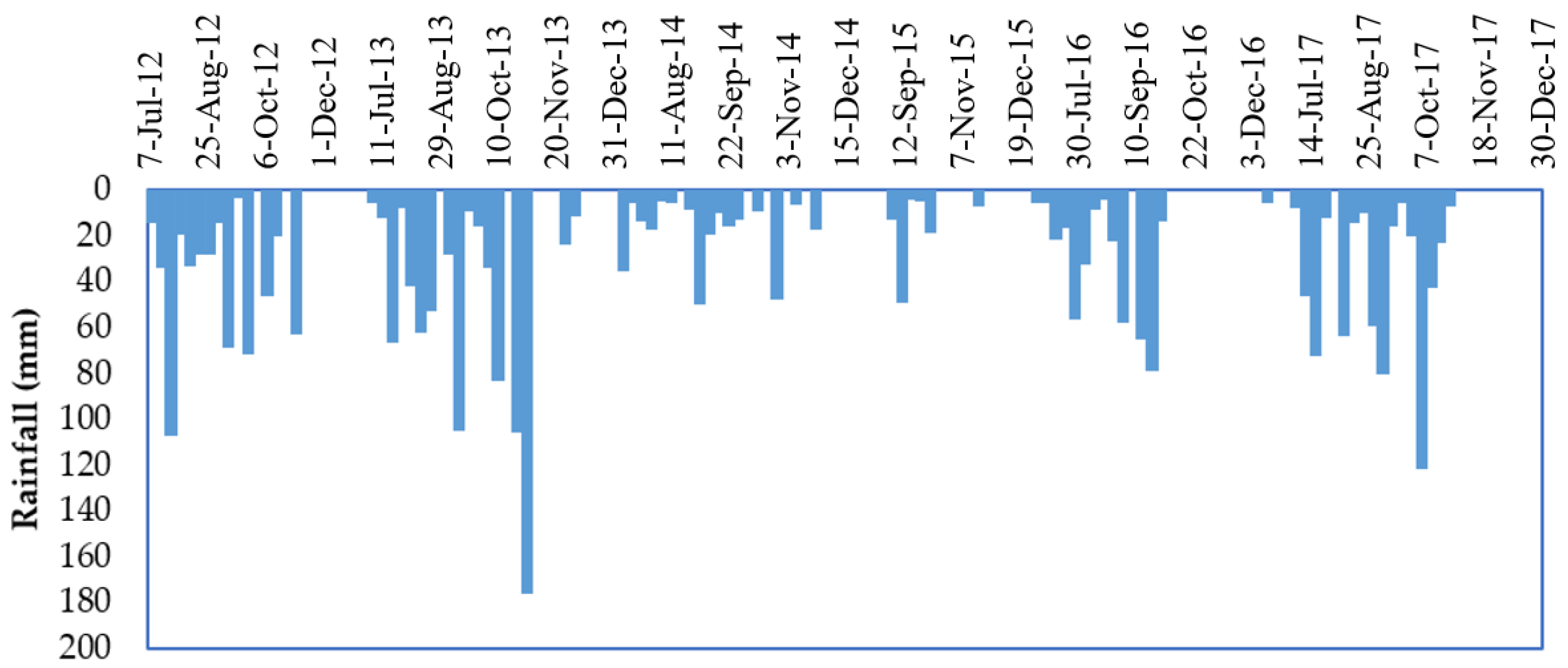
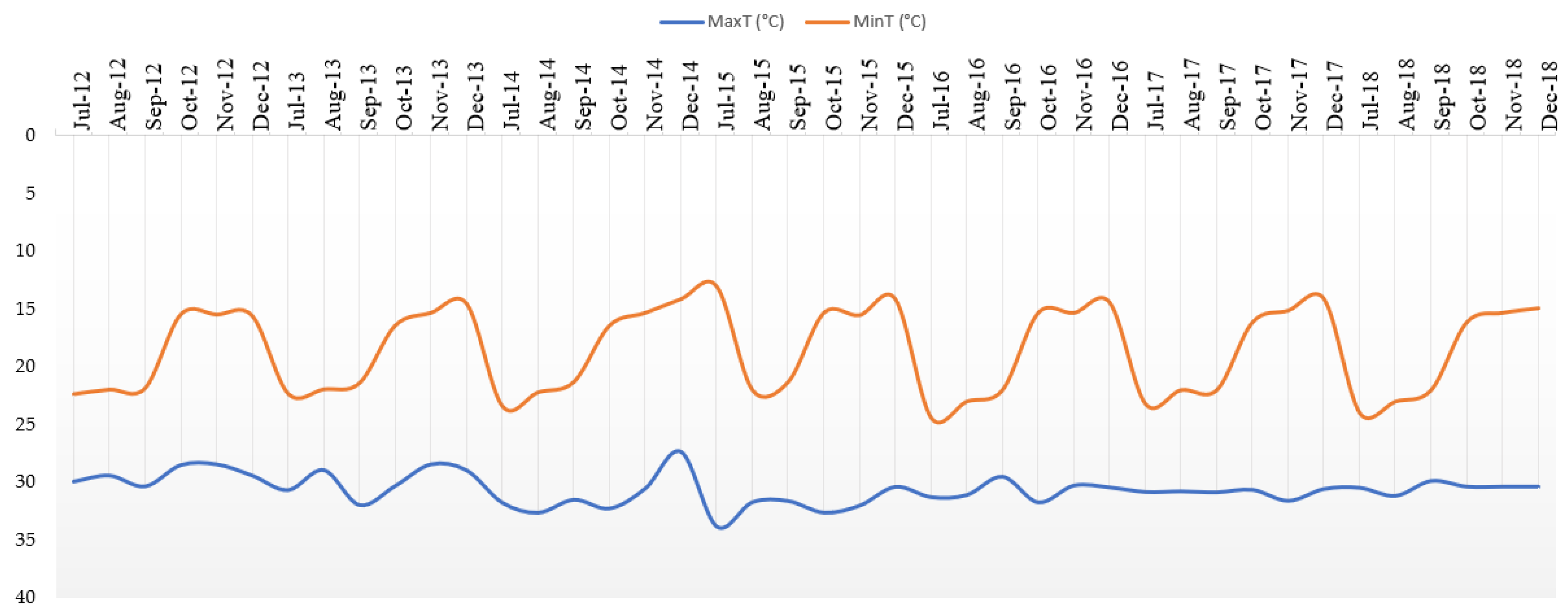
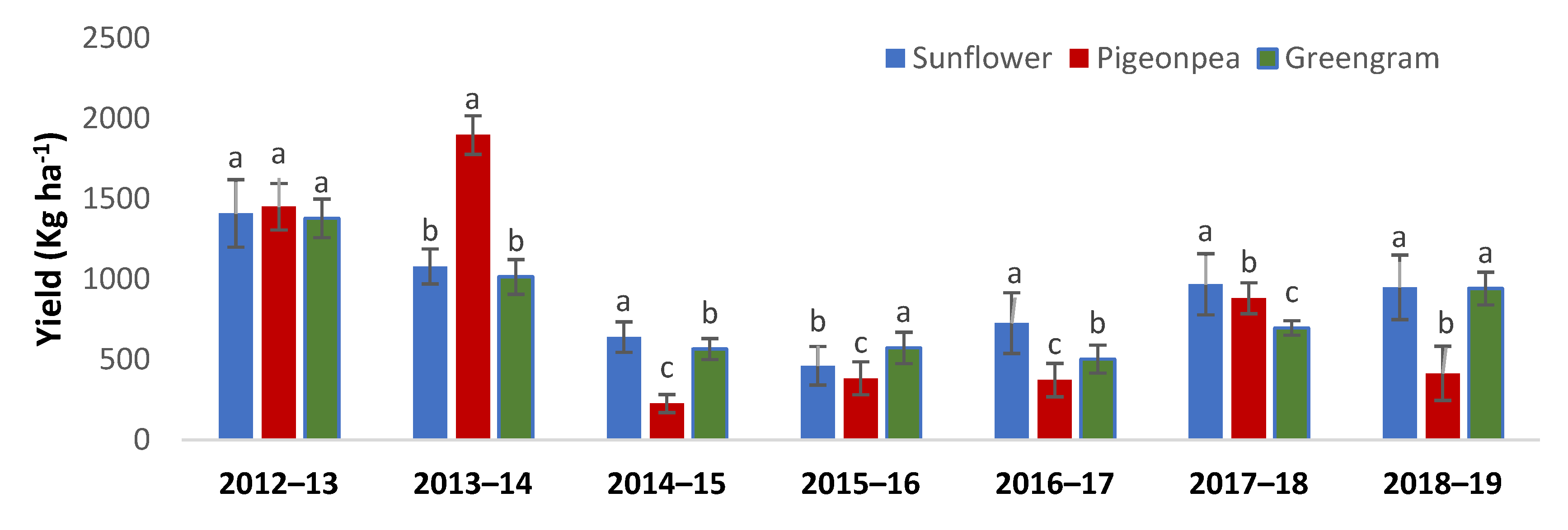
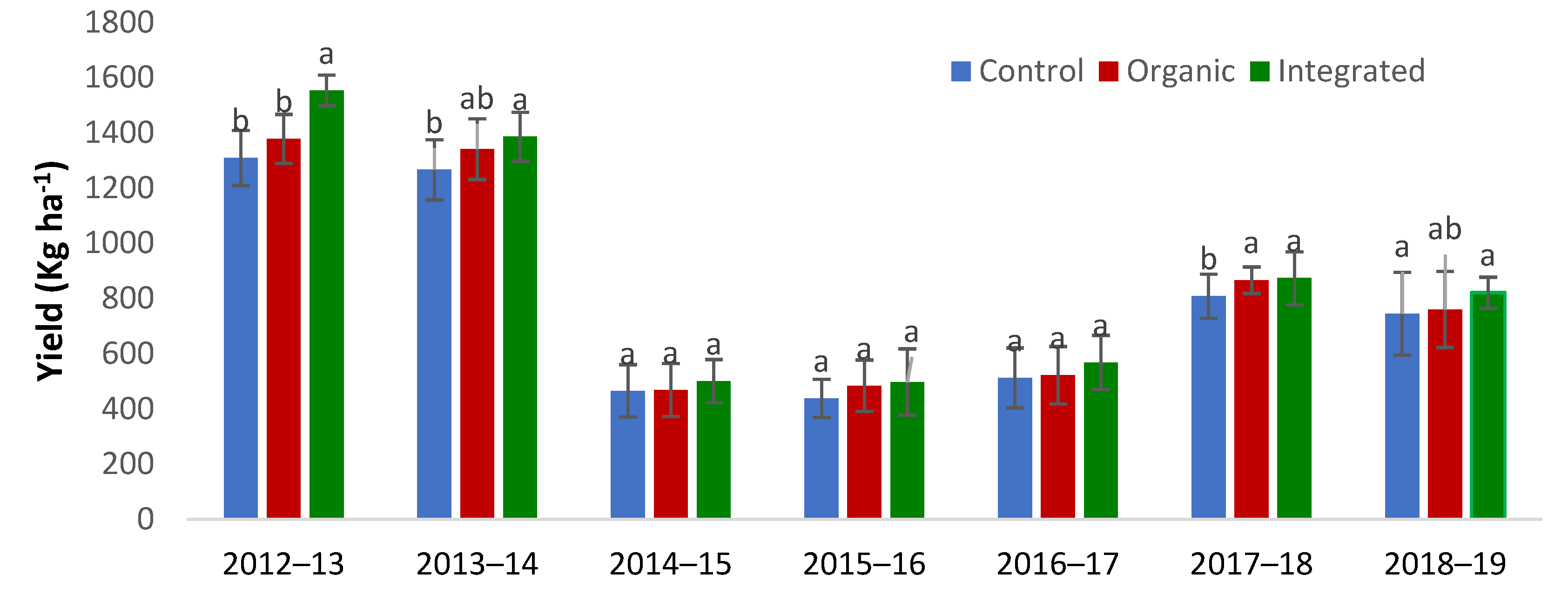
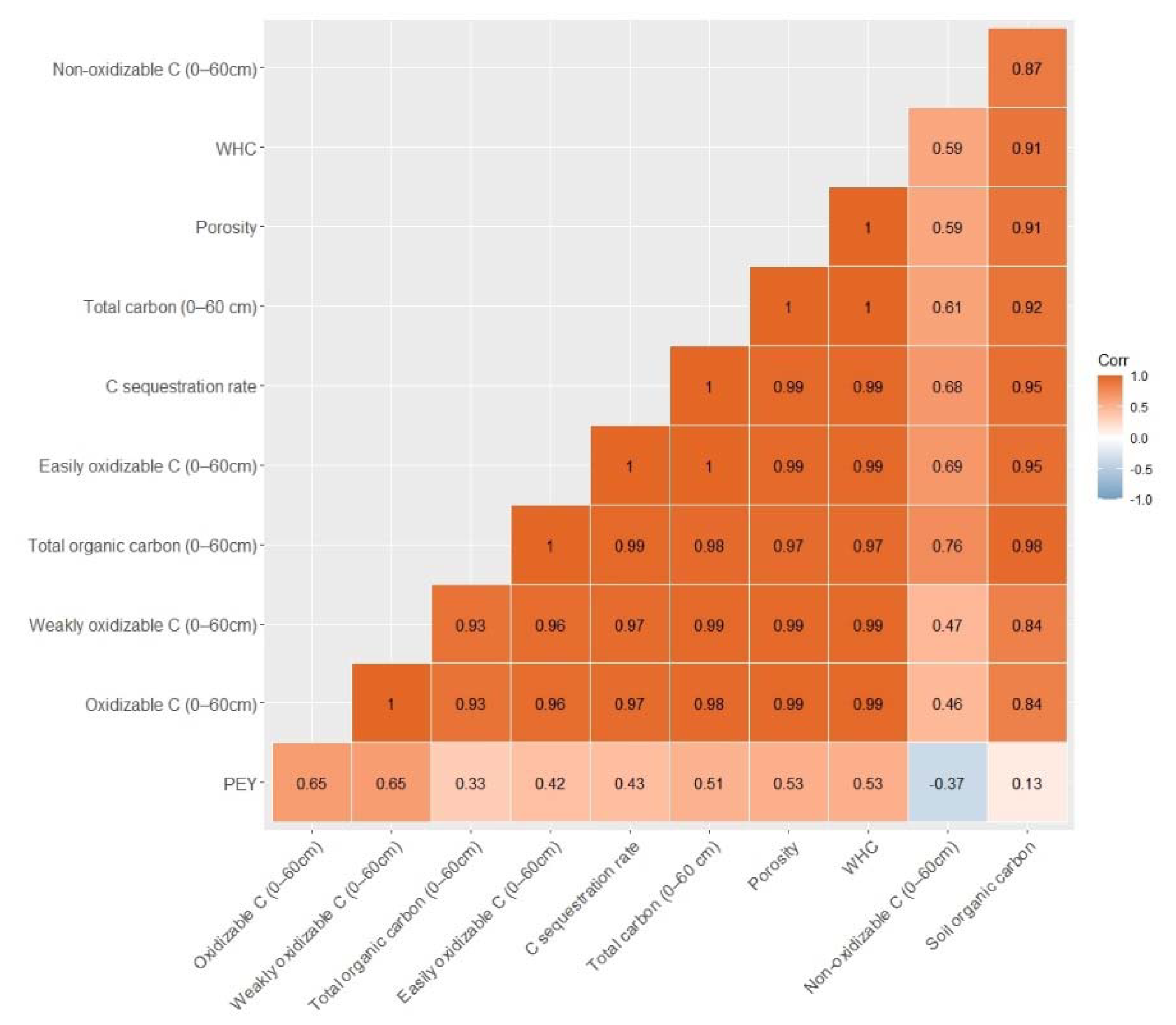
| Crop | Variety | Seed Rate (kg ha−1) | Planting Geometry (cm) |
|---|---|---|---|
| Sunflower | DRSH-1 | 6 | 60 × 30 |
| Greengram | WGG-37 | 15 | 30 × 15 |
| Pigeonpea | PRG-158 | 15 | 90 × 20 |
| Treatment | Sunflower | Pigeonpea | Greengram | ||||||||||||
|---|---|---|---|---|---|---|---|---|---|---|---|---|---|---|---|
| Manure (Mg ha−1) | Mineral Fertilizers (kg ha−1) | Rock Phosphate (kg ha−1) | Manure (Mg ha−1) | Mineral Fertilizers (kg ha−1) | Rock Phosphate (kg ha−1) | Manure (Mg ha−1) | Mineral Fertilizers (kg ha−1) | Rock Phosphate (kg ha−1) | |||||||
| N | P | K | N | P | K | N | P | K | |||||||
| Organic | 13.3 | 0 | 0 | 0 | 0 | 4.4 | 0 | 0 | 0 | 167 | 4.4 | 0 | 0 | 0 | 167 |
| Integrated | 10.0 | 45 | 60 | 30 | 0 | 3.3 | 15 | 50 | 0 | 0 | 3.3 | 15 | 50 | 0 | 0 |
| Control | 0 | 60 | 60 | 30 | 0 | 0 | 20 | 50 | 0 | 0 | 0 | 20 | 50 | 0 | 0 |
| Treatment | Bulk Density (Mg m−3) | Porosity (%) | Water Holding Capacity (%) | ||||||
|---|---|---|---|---|---|---|---|---|---|
| 0–20 cm | 20–40 cm | 40–60 cm | 0–20 cm | 20–40 cm | 40–60 cm | 0–20 cm | 20–40 cm | 40–60 cm | |
| Crop | |||||||||
| Sunflower | 1.24 ± 0.1 a | 1.26 ± 0.1 a | 1.26 ± 0.2 a | 51.21 ± 0.2 b | 44.54 ± 0.4 b | 44.59 ± 0.1 b | 37.03 ± 0.2 b | 42.76 ± 0.2 b | 42.99 ± 0.3 b |
| Pigeonpea | 1.19 ± 0.2 b | 1.21 ± 0.3 b | 1.20 ± 0.2 b | 54.42 ± 0.1 a | 49.52 ± 0.2 a | 47.39 ± 0.1 b | 38.90 ± 0.2 a | 43.90 ± 0.1 a | 45.99 ± 0.4 a |
| Greengram | 1.21 ± 0.1 ab | 1.25 ± 0.1 a | 1.22 ± 0.1 ab | 51.02 ± 0.3 b | 45.93 ± 0.2 b | 47.95 ± 0.3 b | 37.41 ± 0.2 b | 43.04 ± 0.2 ab | 42.74 ± 0.2 b |
| Production system | |||||||||
| Control | 1.25 ± 0.0 a | 1.27 ± 0.1 a | 1.24 ± 0.1 a | 50.97 ± 0.1 b | 45.40 ± 0.2 b | 44.45 ± 0.2 b | 37.24 ± 0.1 b | 41.52 ± 0.1 b | 41.98 ± 0.1 b |
| Organic | 1.18 ± 0.2 b | 1.22 ± 0.2 b | 1.20 ± 0.2 b | 53.56 ± 0.2 a | 46.60 ± 0.2 a | 49.39 ± 0.1 a | 38.65 ± 0.2 a | 44.50 ± 0.2 a | 45.36 ± 0.2 a |
| Integrated | 1.21 ± 0.2 b | 1.24 ± 0.1 b | 1.23 ± 0.1 a | 52.11 ± 0.1 a | 45.99 ± 0.3 ab | 48.08 ± 0.1 a | 37.45 ± 0.1 b | 43.68 ± 0.1 ab | 44.36 ± 0.1 a |
| Treatment | Total Carbon (Mg C ha−1) | Total Inorganic Carbon (Mg C ha−1) | Total Organic Carbon (Mg C ha−1) | ||||||
|---|---|---|---|---|---|---|---|---|---|
| 0–20 cm | 20–40 cm | 40–60 cm | 0–20 cm | 20–40 cm | 40–60 cm | 0–20 cm | 20–40 cm | 40–60 cm | |
| Crop | |||||||||
| Sunflower | 36.09 ± 0.1 c | 32.58 ± 0.1 b | 29.56 ± 0.2 b | 9.81 ± 0.1 b | 9.21 ± 0.2 b | 8.63 ± 0.1 b | 26.28 ± 0.2 b | 23.37 ± 0.1 b | 20.93 ± 0.1 b |
| Pigeonpea | 38.88 ± 0.1 a | 38.18 ± 0.1 a | 36.46 ± 0.1 a | 12.13 ± 0.1 a | 10.52 ± 0.2 b | 11.50 ± 0.1 a | 26.75 ± 0.2 b | 27.66 ± 0.1 a | 24.96 ± 0.2 a |
| Greengram | 37.11 ± 0.2 b | 39.20 ± 0.1 a | 34.83 ± 0.1 a | 10.05 ± 0.1 b | 13.77 ± 0.1 a | 10.72 ± 0.3 a | 27.06 ± 0.2 a | 25.43 ± 0.1 ab | 24.11 ± 0.1 a |
| Production system | |||||||||
| Control | 36.53 ± 0.1 b | 35.67 ± 0.1 a | 31.13 ± 0.1 a | 12.15 ± 0.1 a | 12.33 ± 0.2 a | 10.52 ± 0.1 b | 24.38 ± 0.1 b | 23.34 ± 0.1 b | 20.61 ± 0.2 a |
| Organic | 40.05 ± 0.2 a | 36.27 ± 0.2 a | 33.82 ± 0.2 a | 11.43 ± 0.1 a | 10.46 ± 0.2 b | 11.75 ± 0.2 a | 28.62 ± 0.1 a | 25.81 ± 0.2 a | 22.07 ± 0.1 a |
| Integrated | 38.67 ± 0.1 a | 35.77 ± 0.1 a | 32.87 ± 0.1 a | 12.59 ± 0.2 a | 11.45 ± 0.1 ab | 11.54 ± 0.1 a | 26.08 ± 0.2 a | 24.32 ± 0.1 b | 21.33 ± 0.1 a |
| Treatment | Easily Oxidizable C (Mg C ha−1) | Oxidizable C (Mg C ha−1) | Weakly Oxidizable C (Mg C ha−1) | Non-Oxidizable C (Mg ha−1) | ||||||||
|---|---|---|---|---|---|---|---|---|---|---|---|---|
| 0–20 cm | 20–40 cm | 40–60 cm | 0–20 cm | 20–40 cm | 40–60 cm | 0–20 cm | 20–40 cm | 40–60 cm | 0–20 cm | 20–40 cm | 40–60 cm | |
| Crop | ||||||||||||
| Sunflower | 5.87 ± 0.1 a | 5.01 ± 0.2 b | 4.67 ± 0.1 a | 1.68 ± 0.3 b | 1.48 ± 0.1 b | 1.44 ± 0.1 b | 2.75 ± 0.3 a | 2.22 ± 0.1 b | 2.03 ± 0.1 a | 1.87 ± 0.1 a | 2.92 ± 0.1 a | 3.14 ± 0.1 a |
| Pigeonpea | 5.67 ± 0.2 a | 6.28 ± 0.1 a | 5.35 ± 0.1 a | 1.74 ± 0.1 b | 2.17 ± 0.2 a | 1.70 ± 0.1 a | 3.39 ± 0.2 a | 2.92 ± 0.1 a | 2.31 ± 0.2 a | 1.79 ± 0.2 a | 2.29 ± 0.2 b | 3.13 ± 0.2 a |
| Greengram | 6.34 ± 0.2 a | 5.58 ± 0.2 ab | 4.72 ± 0.2 a | 1.97 ± 0.2 a | 2.09 ± 0.1 a | 1.56 ± 0.1 b | 1.95 ± 0.2 b | 2.43 ± 0.1 ab | 2.10 ± 0.1 a | 1.19 ± 0.2 b | 2.69 ± 0.1 ab | 3.64 ± 0.1 a |
| Production system | ||||||||||||
| Control | 5.89 ± 0.1 b | 4.46 ± 0.1 b | 4.65 ± 0.2 a | 1.69 ± 0.1 b | 1.65 ± 0.1 b | 1.10 ± 0.1 b | 2.66 ± 0.2 b | 1.68 ± 0.2 b | 1.76 ± 0.1 b | 1.80 ± 0.1 a | 2.49 ± 0.2 b | 2.74 ± 0.1 ab |
| Organic | 6.95 ± 0.1 a | 5.94 ± 0.1 a | 5.14 ± 0.2 a | 1.97 ± 0.1 a | 1.99 ± 0.2 a | 1.74 ± 0.1 a | 3.43 ± 0.2 a | 3.26 ± 0.1 a | 2.17 ± 0.1 a | 1.59 ± 0.2 a | 3.44 ± 0.1 a | 2.97 ± 0.2 a |
| Integrated | 6.00 ± 0.1 ab | 5.58 ± 0.1 a | 4.94 ± 0.1 a | 1.83 ± 0.1 ab | 1.89 ± 0.1 ab | 1.66 ± 0.2 a | 3.00 ± 0.2 ab | 2.63 ± 0.2 a | 2.51 ± 0.1 a | 1.45 ± 0.1 a | 2.98 ± 0.3 ab | 2.20 ± 0.1 b |
| Treatment | Soil Organic Carbon (%) | Soil Organic Carbon (Mg C ha−1) | C Sequestration Rate (Mg ha−1 yr−1) | ||||||
|---|---|---|---|---|---|---|---|---|---|
| 0–20 cm | 20–40 cm | 40–60 cm | 0–20 cm | 20–40 cm | 40–60 cm | 0–20 cm | 20–40 cm | 40–60 cm | |
| Crop | |||||||||
| Sunflower | 0.51 ± 0.1 c | 0.47 ± 0.2 b | 0.41 ± 0.1 b | 12.55 ± 0.2 b | 11.90 ± 0.2 b | 10.41 ± 0.1 a | 0.30 ± 0.1 b | 0.19 ± 0.2 b | 0.07 ± 0.2 b |
| Pigeonpea | 0.56 ± 0.2 b | 0.59 ± 0.1 a | 0.51 ± 0.2 a | 13.38 ± 0.2 b | 14.30 ± 0.1 a | 11.93 ± 10.2 a | 0.57 ± 0.2 a | 0.40 ± 0.1 a | 0.25 ± 0.1 a |
| Greengram | 0.62 ± 0.1 a | 0.50 ± 0.1 b | 0.44 ± 0.1 b | 14.63 ± 0.1 a | 12.55 ± 0.2 b | 10.74 ± 0.1 a | 0.48 ± 0.1 a | 0.23 ± 0.1 b | 0.20 ± 0.2 a |
| Production system | |||||||||
| Control | 0.54 ± 0.2 b | 0.49 ± 0.1 b | 0.42 ± 0.1 b | 12.96 ± 0.2 b | 12.34 ± 0.1 b | 10.33 ± 0.2 b | 0.02 ± 0.1 c | 0.01 ± 0.2 c | 0.04 ± 0.2 c |
| Organic | 0.60 ± 0.2 a | 0.57 ± 0.1 a | 0.50 ± 10.2 a | 13.98 ± 0.2 a | 13.79 ± 0.2 a | 11.80 ± 0.2 a | 0.85 ± 0.1 a | 0.55 ± 0.2 a | 0.21 ± 0.2 a |
| Integrated | 0.55 ± 0.2 b | 0.51 ± 0.2 b | 0.44 ± 0.1 b | 13.56 ± 0.2 a | 12.65 ± 0.2 b | 10.95 ± 0.2 b | 0.49 ± 0.2 b | 0.25 ± 0.1 b | 0.12 ± 0.2 b |
Publisher’s Note: MDPI stays neutral with regard to jurisdictional claims in published maps and institutional affiliations. |
© 2022 by the authors. Licensee MDPI, Basel, Switzerland. This article is an open access article distributed under the terms and conditions of the Creative Commons Attribution (CC BY) license (https://creativecommons.org/licenses/by/4.0/).
Share and Cite
Gopinath, K.A.; Rajanna, G.A.; Venkatesh, G.; Jayalakshmi, M.; Kumari, V.V.; Prabhakar, M.; Rajkumar, B.; Chary, G.R.; Singh, V.K. Influence of Crops and Different Production Systems on Soil Carbon Fractions and Carbon Sequestration in Rainfed Areas of Semiarid Tropics in India. Sustainability 2022, 14, 4207. https://doi.org/10.3390/su14074207
Gopinath KA, Rajanna GA, Venkatesh G, Jayalakshmi M, Kumari VV, Prabhakar M, Rajkumar B, Chary GR, Singh VK. Influence of Crops and Different Production Systems on Soil Carbon Fractions and Carbon Sequestration in Rainfed Areas of Semiarid Tropics in India. Sustainability. 2022; 14(7):4207. https://doi.org/10.3390/su14074207
Chicago/Turabian StyleGopinath, Kodigal A., Gandhamanagenahalli A. Rajanna, Govindarajan Venkatesh, Mitnala Jayalakshmi, Venugopalan Visha Kumari, Mathyam Prabhakar, Bollam Rajkumar, Gajjala Ravindra Chary, and Vinod Kumar Singh. 2022. "Influence of Crops and Different Production Systems on Soil Carbon Fractions and Carbon Sequestration in Rainfed Areas of Semiarid Tropics in India" Sustainability 14, no. 7: 4207. https://doi.org/10.3390/su14074207
APA StyleGopinath, K. A., Rajanna, G. A., Venkatesh, G., Jayalakshmi, M., Kumari, V. V., Prabhakar, M., Rajkumar, B., Chary, G. R., & Singh, V. K. (2022). Influence of Crops and Different Production Systems on Soil Carbon Fractions and Carbon Sequestration in Rainfed Areas of Semiarid Tropics in India. Sustainability, 14(7), 4207. https://doi.org/10.3390/su14074207






